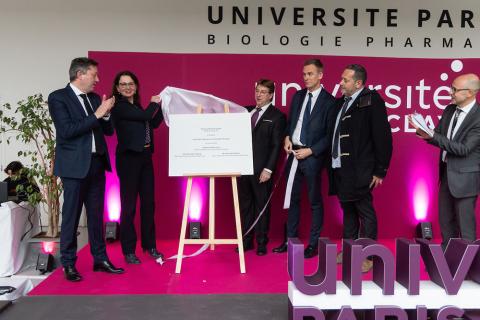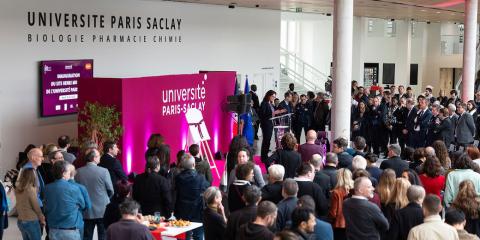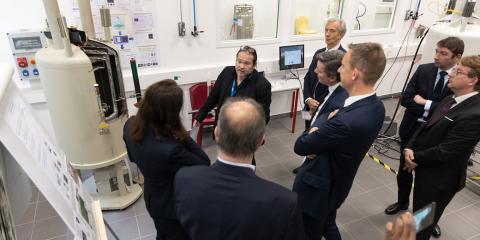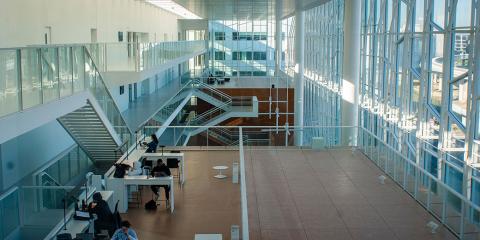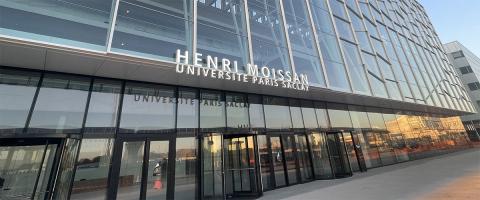
Inauguration of the Henri Moissan site at Université Paris-Saclay
The Henri Moissan building for biology, pharmacy and chemistry activities at Université Paris-Saclay was inaugurated on Tuesday 18 Avril 2023 by Estelle Iacona, President of Université Paris-Saclay, Marc Pallardy, Dean of the Faculty of Pharmacy and Denis Merlet, Dean of the Orsay Faculty of Science.
The Henri Moissan site regroups the Faculty of Pharmacy (previously located at Châtenay-Malabry), the Orsay Institute for Molecular Chemistry and Materials (ICCMO - Univ. Paris-Saclay/CNRS), auditoriums, and spaces for teaching and practical work for the Faculty of Science’s Biology and Chemistry Master’s students. In total, some 3,300 students and 1,000 researchers, lecturers and admin staff moved to the site in September 2023.
For Université Paris-Saclay, the project meets several important challenges. The modern site complies with the most recent sustainable development and energy efficiency standards1, and provides students and staff with an optimal daily working environment. Regrouping the different activities in a single place also encourages interdisciplinarity and scientific collaborations by connecting teaching and research subjects which are at the interface between biology, pharmacy and chemistry, reinforcing the way the university tackles major future societal challenges in energy and health in particular. The inclusion of areas for teaching in the building, particularly for Master’s programmes, brings students closer to laboratories, supporting the close relationship between teaching and research, which is one of the pillars of the university’s educational policy.
Furthermore, its location at the heart of the Moulon neighbourhood within the Paris-Saclay urban campus strengthens the cohesion between the university’s various members who are already present on the plateau de Saclay, including the Orsay Faculty of Science, the Orsay University Technical Institute (IUT), and Polytech Paris-Saclay, but also its Grandes Écoles, including CentraleSupélec and ENS Paris-Saclay, as well as the future LUMEN learning centre.
With a total surface area of 74,000 m², the site’s central space, the Coeur de Pôle, and teaching spaces were designed by Bernard Tschumi (BTuA agency), while the research areas were designed by the agency, Groupe-6. Made up of several interlinking buildings, the building possesses an impressive façade overlooking the grand avenue of the Moulon neighbourhood and faces the future Grand Paris Express metro line 18. The all-glass façade reveals two auditoriums which appear to be hanging in the air.
The site is organised around the Cœur de Pôle, a central space where the university’s communities meet and cross paths, while spaces for research and teaching are located on either side. On the first and second floors, two main corridors connect the buildings, spanning the length of the streets and linking the buildings together with glass walkways. This Avenue des Sciences gives users uninterrupted access to the building’s research and teaching areas, whilst providing café areas and spaces to relax.
In addition to the Henri Moissan site, the Biology, Pharmacy and Chemistry hub at Université Paris-Saclay is part of a property complex that includes the IDEEV site. With a total surface area of 14,000 m², the site is home to the Institute of Diversity, Ecology and Evolution of Living Beings (IDEEV– Université Paris-Saclay/CNRS/Inrae/AgroParisTech/IRD). The project was one of the biggest university construction projects in France. Its design, construction, operation and maintenance were carried out as part of a public-private partnership contract lasting 29 years, involving Platon Saclay, Bouygues Construction, Bouygues Energies & Services and Bouygues Energies & Services FM France.
The project was awarded government funding by the French National Research Agency (ANR) as part of the Investissement d’Avenir programme.
From left to right: Bertrand Gaume, Prefect of Essonne, Estelle Iacona, President of Université Paris-Saclay, David Ros, Mayor of Orsay, Alexander Grimaud, Deputy Prefect of the Palaiseau district, Pierre Joutard, Interim CEO of the Paris-Saclay public authority, Antoine Latreille, Vice-President for Estates and Development at Université Paris-Saclay.
1 Both the Henri Moissan and IDEEV sites are certified High Environmental Quality and are highly energy efficient. The buildings are connected to the Paris-Saclay district heating and cooling network, which uses deep geothermal energy.

